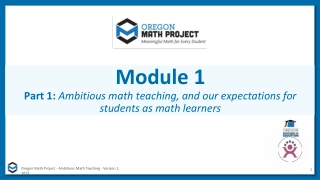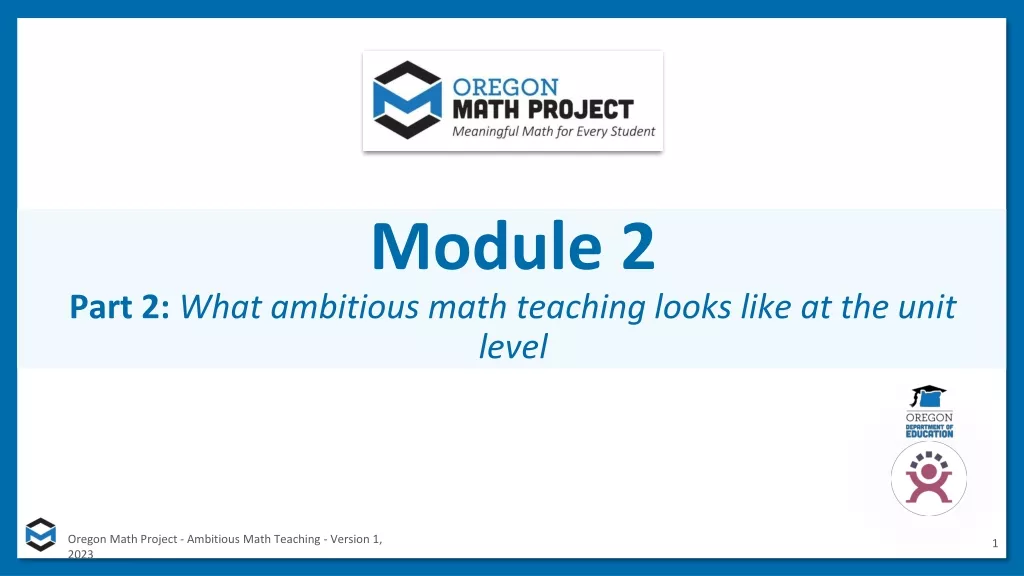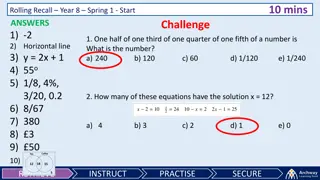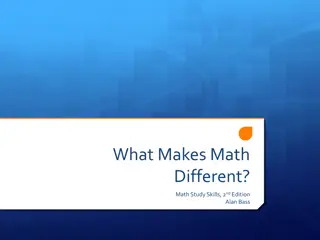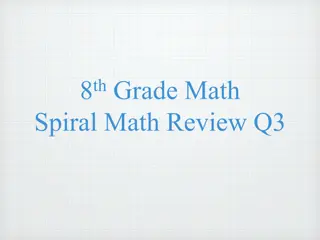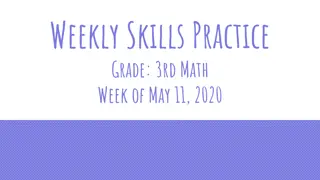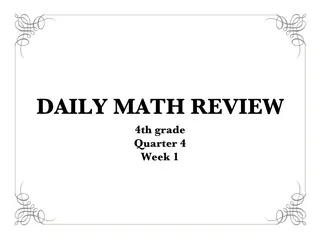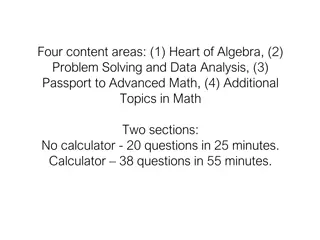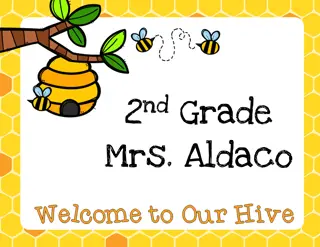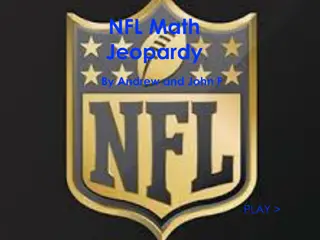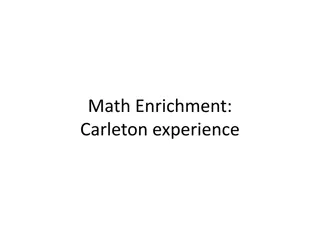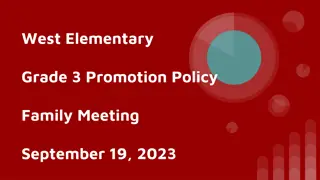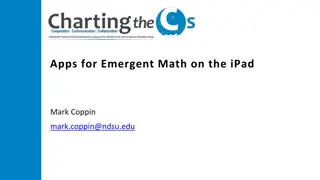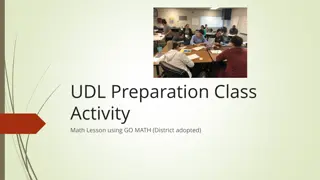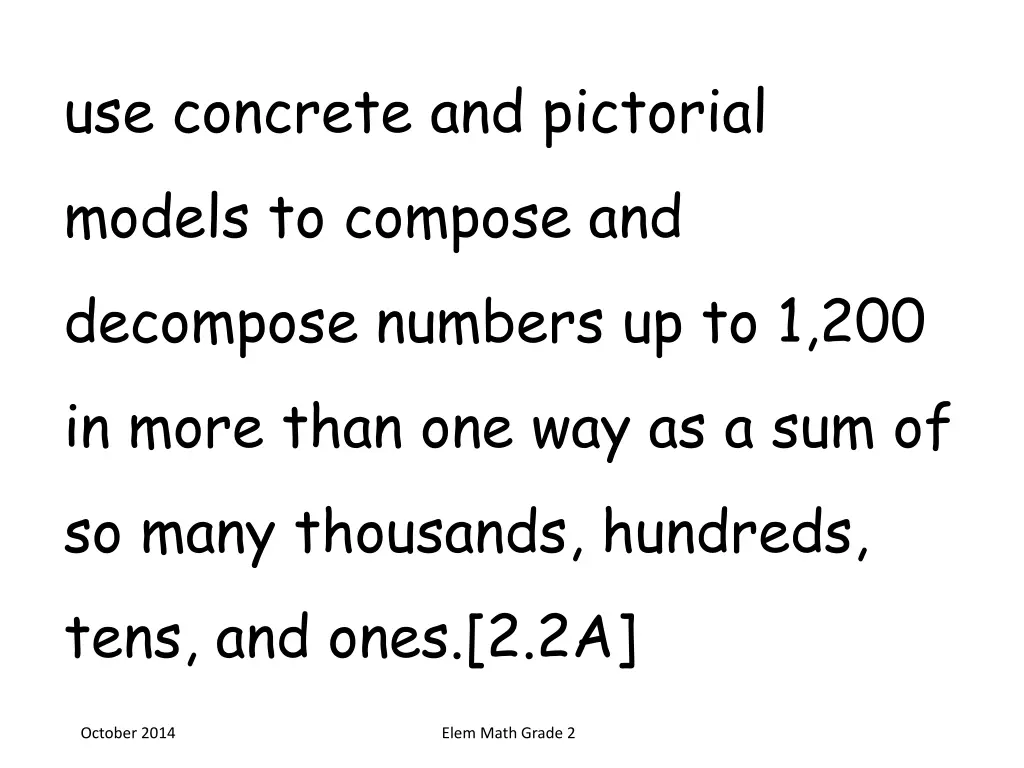
Exploring Number Composition, Decomposition, and Comparison in Elementary Math
Dive into the world of numbers as elementary math students use concrete and pictorial models to compose and decompose numbers up to 1,200 in multiple ways. They also learn to represent numbers in standard, word, and expanded forms, generate numbers relative to given values, use place value for comparison, and order numbers. Activities include locating numbers on number lines, identifying fractional parts, and understanding the relationship between fraction parts and wholes. Engage young learners with practical math concepts that lay a strong foundation for further mathematical understanding.
Uploaded on | 1 Views
Download Presentation

Please find below an Image/Link to download the presentation.
The content on the website is provided AS IS for your information and personal use only. It may not be sold, licensed, or shared on other websites without obtaining consent from the author. If you encounter any issues during the download, it is possible that the publisher has removed the file from their server.
You are allowed to download the files provided on this website for personal or commercial use, subject to the condition that they are used lawfully. All files are the property of their respective owners.
The content on the website is provided AS IS for your information and personal use only. It may not be sold, licensed, or shared on other websites without obtaining consent from the author.
E N D
Presentation Transcript
use concrete and pictorial models to compose and decompose numbers up to 1,200 in more than one way as a sum of so many thousands, hundreds, tens, and ones.[2.2A] October 2014 Elem Math Grade 2
use standard, word, and expanded forms to represent numbers up to 1,200. [2.2B] October 2014 Elem Math Grade 2
generate a number that is greater than or less than a given whole number up to 1,200.[2.2C] October 2014 Elem Math Grade 2
use place value to compare and order whole numbers up to 1,200 using comparative language, numbers, and symbols (>, <, or =). [2.2D] October 2014 Elem Math Grade 2
locate the position of a given whole number on an open number line.[2.2E] October 2014 Elem Math Grade 2
name the whole number that corresponds to a specific point on a number line.[2.2F] October 2014 Elem Math Grade 2
partition objects into equal parts and name the parts, including halves, fourths, and eighths, using words.[2.3A] October 2014 Elem Math Grade 2
explain that the more fractional parts used to make a whole, the smaller the part; and the fewer the fractional parts, the larger the part.[2.3B] October 2014 Elem Math Grade 2
use concrete models to count fractional parts beyond one whole using words and recognize how many parts it takes to equal one whole.[2.3C] October 2014 Elem Math Grade 2
identify examples and non- examples of halves, fourths, and eighths.[2.3D] October 2014 Elem Math Grade 2
recall basic facts to add and subtract within 20 with automaticity.[2.4A] October 2014 Elem Math Grade 2
add up to four two-digit numbers and subtract two-digit numbers using mental strategies and algorithms based on knowledge of place value and properties of operations.[2.4B] October 2014 Elem Math Grade 2
solve one-step and multi-step word problems involving addition and subtraction within 1,000 using a variety of strategies based on place value, including algorithms.[2.4C] October 2014 Elem Math Grade 2
generate and solve problem situations for a given mathematical number sentence involving addition and subtraction of whole numbers within 1,000.[2.4D] October 2014 Elem Math Grade 2
determine the value of a collection of coins up to one dollar.[2.5A] October 2014 Elem Math Grade 2
use the cent symbol, dollar sign, and the decimal point to name the value of a collection of coins.[2.5B] October 2014 Elem Math Grade 2
model, create, and describe contextual multiplication situations in which equivalent sets of concrete objects are joined.[2.6A] October 2014 Elem Math Grade 2
model, create, and describe contextual division situations in which a set of concrete objects is separated into equivalent sets.[2.6B] October 2014 Elem Math Grade 2
determine whether a number up to 40 is even or odd using pairings of objects to represent the number.[2.7A] October 2014 Elem Math Grade 2
use an understanding of place value to determine the number that is 10 or 100 more or less than a given number up to 1,200.[2.7B] October 2014 Elem Math Grade 2
represent and solve addition and subtraction word problems where unknowns may be any one of the terms in the problem.[2.7C] October 2014 Elem Math Grade 2
create two-dimensional shapes based on given attributes, including number of sides and vertices.[2.8A] October 2014 Elem Math Grade 2
classify and sort three-dimensional solids, including spheres, cones, cylinders, rectangular prisms (including cubes as special rectangular prisms), and triangular prisms, based on attributes using formal geometric language.[2.8B] October 2014 Elem Math Grade 2
classify and sort polygons with 12 or fewer sides according to attributes, including identifying the number of sides and number of vertices.[2.8C] October 2014 Elem Math Grade 2
compose two-dimensional shapes and three-dimensional solids with given properties or attributes.[2.8D] October 2014 Elem Math Grade 2
decompose two-dimensional shapes such as cutting out a square from a rectangle, dividing a shape in half, or partitioning a rectangle into identical triangles and identify the resulting geometric parts.[2.8E] October 2014 Elem Math Grade 2
find the length of objects using concrete models for standard units of length.[2.9A] October 2014 Elem Math Grade 2
describe the inverse relationship between the size of the unit and the number of units needed to equal the length of an object.[2.9B] October 2014 Elem Math Grade 2
represent whole numbers as distances from any given location on a number line.[2.9C] October 2014 Elem Math Grade 2
determine the length of an object to the nearest marked unit using rulers, yardsticks, meter sticks, or measuring tapes.[2.9D] October 2014 Elem Math Grade 2
determine a solution to a problem involving length, including estimating lengths.[2.9E] October 2014 Elem Math Grade 2
use concrete models of square units to find the area of a rectangle by covering it with no gaps or overlaps, counting to find the total number of square units, and describing the measurement using a number and the unit.[2.9F] October 2014 Elem Math Grade 2
read and write time to the nearest one-minute increment using analog and digital clocks and distinguish between a.m. and p.m.[2.9G] October 2014 Elem Math Grade 2
explain that the length of a bar in a bar graph or the number of pictures in a pictograph represents the number of data points for a given category.[2.10A] October 2014 Elem Math Grade 2
organize a collection of data with up to four categories using pictographs and bar graphs with intervals of one or more.[2.10B] October 2014 Elem Math Grade 2
write and solve one-step word problems involving addition or subtraction using data represented within pictographs and bar graphs with intervals of one.[2.10C] October 2014 Elem Math Grade 2
draw conclusions and make predictions from information in a graph.[2.10D] October 2014 Elem Math Grade 2
calculate how money saved can accumulate into a larger amount over time.[2.11A] October 2014 Elem Math Grade 2
explain that saving is an alternative to spending.[2.11B] October 2014 Elem Math Grade 2
distinguish between a deposit and a withdrawal.[2.11C] October 2014 Elem Math Grade 2
identify examples of borrowing and distinguish between responsible and irresponsible borrowing.[2.11D] October 2014 Elem Math Grade 2
identify examples of lending and use concepts of benefits and costs to evaluate lending decisions.[2.11E] October 2014 Elem Math Grade 2
differentiate between producers and consumers and calculate the cost to produce a simple item.[2.11F] October 2014 Elem Math Grade 2
compose and decompose numbers up to 100,000 as a sum of so many ten thousands, so many thousands, so many hundreds, so many tens, and so many ones using objects, pictorial models, and numbers, including expanded notation as appropriate.[3.2A] October 2014 Elem Math Grade 2
describe the mathematical relationships found in the base-10 place value system through the hundred thousands place.[3.2B] October 2014 Elem Math Grade 2
represent a number on a number line as being between two consecutive multiples of 10; 100; 1,000; or 10,000 and use words to describe relative size of numbers in order to round whole numbers.[3.2C] October 2014 Elem Math Grade 2

